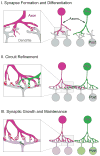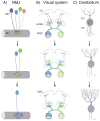Identifying roles for neurotransmission in circuit assembly: insights gained from multiple model systems and experimental approaches
- PMID: 21110347
- PMCID: PMC4019509
- DOI: 10.1002/bies.201000095
Identifying roles for neurotransmission in circuit assembly: insights gained from multiple model systems and experimental approaches
Abstract
In the adult nervous system, chemical neurotransmission between neurons is essential for information processing. However, neurotransmission is also important for patterning circuits during development, but its precise roles have yet to be identified, and some remain highly debated. Here, we highlight viewpoints that have come to be widely accepted or still challenged. We discuss how distinct techniques and model systems employed to probe the developmental role of neurotransmission may reconcile disparate ideas. We underscore how the effects of perturbing neurotransmission during development vary with model systems, the stage of development when transmission is altered, the nature of the perturbation, and how connectivity is assessed. Based on findings in circuits with connectivity arranged in layers, we raise the possibility that there exist constraints in neuronal network design that limit the role of neurotransmission. We propose that activity-dependent mechanisms are effective in refining connectivity patterns only when inputs from different cells are close enough, spatially, to influence each other's outcome.
Figures






References
-
- Hubel DH, Wiesel TN, LeVay S. Plasticity of ocular dominance columns in monkey striate cortex. Philos Trans R Soc Lond B Biol Sci. 1977;278:377–409. - PubMed
-
- LeVay S, Wiesel TN, Hubel DH. The development of ocular dominance columns in normal and visually deprived monkeys. J Comp Neurol. 1980;191:1–51. - PubMed
-
- Sanes JR, Lichtman JW. Development of the vertebrate neuromuscular junction. Annu Rev Neurosci. 1999;22:389–442. - PubMed
-
- Hume RI, Role LW, Fischbach GD. Acetylcholine release from growth cones detected with patches of acetylcholine receptor-rich membranes. Nature. 1983;305:632–4. - PubMed
-
- Taylor J, Docherty M, Gordon-Weeks PR. GABAergic growth cones: release of endogenous gamma-aminobutyric acid precedes the expression of synaptic vesicle antigens. J Neurochem. 1990;54:1689–99. - PubMed
Publication types
MeSH terms
Grants and funding
LinkOut - more resources
Full Text Sources

